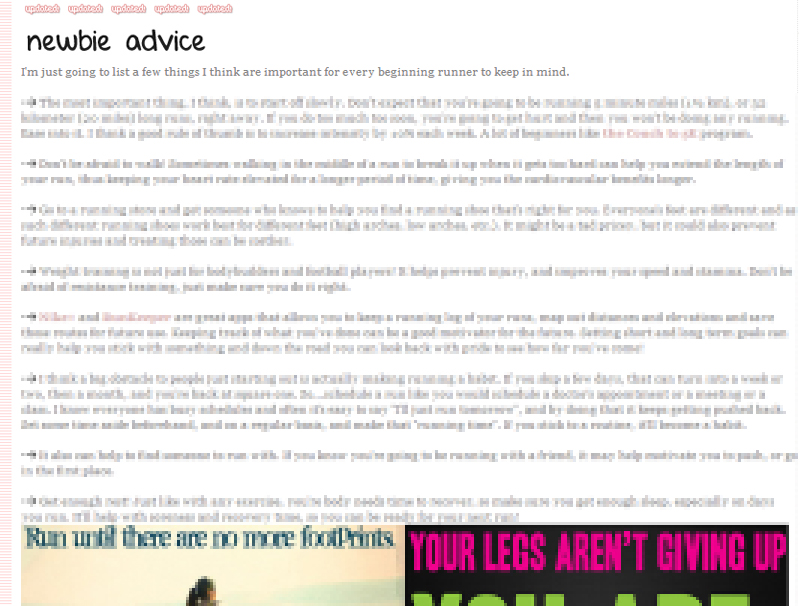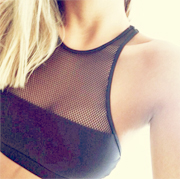Abs?
 time: 19:15:34
time: 19:15:34  Eat clean in a caloric deficit
Eat clean in a caloric deficit Cut out simple carbs, junk food, sodas, condiments and sugary/processed foods
Cut out simple carbs, junk food, sodas, condiments and sugary/processed foods Control blood sugar by eating small meals every few hours
Control blood sugar by eating small meals every few hours Consume lean protein at each meal
Consume lean protein at each meal Incorporate some HIIT (high intensive interval training) a few times a week
Incorporate some HIIT (high intensive interval training) a few times a week Drink plenty of water
Drink plenty of water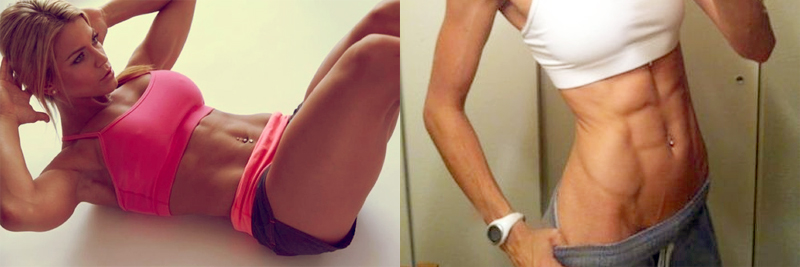
 Äta rent med ett underskott av kalorier
Äta rent med ett underskott av kalorier Plocka bort snabba kolhydrater, skräpmat, läsk, såser och livsmedel som innehåller socker/är bearbetade från ditt intag
Plocka bort snabba kolhydrater, skräpmat, läsk, såser och livsmedel som innehåller socker/är bearbetade från ditt intag Håll blodsockernivån under kontroll genom att äta små måltider med ett par timmars mellanrum
Håll blodsockernivån under kontroll genom att äta små måltider med ett par timmars mellanrum Få i dig magert protein vid varje måltid
Få i dig magert protein vid varje måltid Träna HIIT (högintensiv intervallträning) några gånger i veckan
Träna HIIT (högintensiv intervallträning) några gånger i veckan Drick mängder med vatten
Drick mängder med vattenMost effective exercises for belly fat
 time: 14:45:00
time: 14:45:00 
How to Maximize Those Butt-Toning Squats!
 time: 21:28:33
time: 21:28:33 
Can you hit it too hard? 10 signs & symptoms of overtraining
 time: 16:04:00
time: 16:04:00 
 A decrease in performance. If you’re training hard and you notice that you just aren’t able to do what you know you CAN DO (having to reduce your weights, not being able to finish a set, needing to take more breaks etc), it might be a sign that your muscles have not gotten enough recovery time.
A decrease in performance. If you’re training hard and you notice that you just aren’t able to do what you know you CAN DO (having to reduce your weights, not being able to finish a set, needing to take more breaks etc), it might be a sign that your muscles have not gotten enough recovery time.  Problems sleeping, decrease in overall energy, mood swings etc. Workouts generally should BOOST your energy and mood. If the days seem ‘harder’ it might be a sign you need to take a step back. Depression can be a symptom of overtraining as well.
Problems sleeping, decrease in overall energy, mood swings etc. Workouts generally should BOOST your energy and mood. If the days seem ‘harder’ it might be a sign you need to take a step back. Depression can be a symptom of overtraining as well. Feeling that unless your workout is 2 hours long, it doesn’t count. The truth is, there is ONLY so much you can push your body. After a certain amount of time, it releases chemicals and begins processes to minimize damage… NOT to help you get stronger, fitter or better. 2 hours a day in the gym is too much. Psychologically, this is a barrier a lot of people get stuck behind. Often, beginners are encouraged to workout for long periods of time, but at a VERY LOW intensity. The higher the intensity, the shorter your workout can be. Work to limit your workouts to an hour or less, take less breaks, and boost your intensity instead.
Feeling that unless your workout is 2 hours long, it doesn’t count. The truth is, there is ONLY so much you can push your body. After a certain amount of time, it releases chemicals and begins processes to minimize damage… NOT to help you get stronger, fitter or better. 2 hours a day in the gym is too much. Psychologically, this is a barrier a lot of people get stuck behind. Often, beginners are encouraged to workout for long periods of time, but at a VERY LOW intensity. The higher the intensity, the shorter your workout can be. Work to limit your workouts to an hour or less, take less breaks, and boost your intensity instead. You blow off friends, family, work, responsibilities etc. in order to workout. Fitness is supposed to ENHANCE our lives… not BE our lives. What’s the good in having a body that does more if you’re not using it to do the things you love? If you’re constantly avoiding the things you need to do in order to fit in your workouts, try to plan a bit better and work on time management. Priorities please!
You blow off friends, family, work, responsibilities etc. in order to workout. Fitness is supposed to ENHANCE our lives… not BE our lives. What’s the good in having a body that does more if you’re not using it to do the things you love? If you’re constantly avoiding the things you need to do in order to fit in your workouts, try to plan a bit better and work on time management. Priorities please! You push through pain and illness in order to sweat. Your #1 responsibility is to TAKE CARE of your body. And that includes giving it time to heal. Consistently not taking that time can have negative consequences on your body and may be a sign you need to approach things differently.
You push through pain and illness in order to sweat. Your #1 responsibility is to TAKE CARE of your body. And that includes giving it time to heal. Consistently not taking that time can have negative consequences on your body and may be a sign you need to approach things differently.  You’re gaining or maintaining body fat… when you ‘should’ be losing. While it’s normal to have to tweak your routine to keep results coming, if you start holding on to more body fat, it could be a sign your body has gone into survival mode. Usually there’s a decrease in muscle as well (it’s what your body is using for fuel instead of fat). Our bodies need fat to survive, and if it feels like you’re tapping into the supply to hard or too fast, it will give the “order” to use muscle instead to save it’s fat stores. When our bodies feel “safe” they readily give up fat as energy: they know you’re taking care of things. If you’re pushing hard, eating clean and getting nowhere, a break may be in order.
You’re gaining or maintaining body fat… when you ‘should’ be losing. While it’s normal to have to tweak your routine to keep results coming, if you start holding on to more body fat, it could be a sign your body has gone into survival mode. Usually there’s a decrease in muscle as well (it’s what your body is using for fuel instead of fat). Our bodies need fat to survive, and if it feels like you’re tapping into the supply to hard or too fast, it will give the “order” to use muscle instead to save it’s fat stores. When our bodies feel “safe” they readily give up fat as energy: they know you’re taking care of things. If you’re pushing hard, eating clean and getting nowhere, a break may be in order.  You’re HIITING, lifting, pushing beyond or sprinting each and every day. It’s good to have the occasional blow out at the gym, but training this intensely every single day gives your body no time to HEAL (and no time doesn't give you the results you’re looking for). It may feel better to your ego, but unless you’re Wolverine, you should alternate intense workouts with moderate ones, and take rest days when possible. Being fit enough to run 10 miles a day doesn’t mean you SHOULD.
You’re HIITING, lifting, pushing beyond or sprinting each and every day. It’s good to have the occasional blow out at the gym, but training this intensely every single day gives your body no time to HEAL (and no time doesn't give you the results you’re looking for). It may feel better to your ego, but unless you’re Wolverine, you should alternate intense workouts with moderate ones, and take rest days when possible. Being fit enough to run 10 miles a day doesn’t mean you SHOULD.  You’re constantly sore/in pain. Some people are never sore. Others are sore more often (like ME). But there’s a difference between the kind of sore you can manage, and the kind of sore that makes it impossible to put on your shirt and walk up stairs. Being THAT sore EVERYDAY? Not good. Scale back and take a few recovery days.
You’re constantly sore/in pain. Some people are never sore. Others are sore more often (like ME). But there’s a difference between the kind of sore you can manage, and the kind of sore that makes it impossible to put on your shirt and walk up stairs. Being THAT sore EVERYDAY? Not good. Scale back and take a few recovery days.  You’re always SICK. More than usual. Taking a few extra days/weeks off can help your body heal more than just your muscles.
You’re always SICK. More than usual. Taking a few extra days/weeks off can help your body heal more than just your muscles.  Heart palpitations or increased heart rate AT REST. Generally, the more fit you are, the lower your resting heart rate: your heart doesn’t have to work as hard because it’s more efficient and strong. But if it starts having to work harder, i.e. beat more, or if it’s beats become irregular, it may be a sign you need to cut back. And maybe see a doctor.
Heart palpitations or increased heart rate AT REST. Generally, the more fit you are, the lower your resting heart rate: your heart doesn’t have to work as hard because it’s more efficient and strong. But if it starts having to work harder, i.e. beat more, or if it’s beats become irregular, it may be a sign you need to cut back. And maybe see a doctor.
- Walking
- Hikes (easy)
- Easy yoga
- Extended stretching (30-45 minutes of stretches)
- Cycling
- Frisbee
- Sex
- Massages
- Hanging with friends
- Crafts
- Shopping
Motivate yourself for a winter run
 time: 18:58:20
time: 18:58:20 - Warm up your clothes: Pop your sports bra, shirts, pants, and even your socks in the dryer for a couple minutes. Slipping on warm gear is sure to get rid of that chill you have when looking out your window into the cold.
- Warm up yourself: Take a quick shower allowing the hot water to envelope your skin, being careful not to get your hair wet. It'll warm your body and get your muscles ready to move.
- Warm up inside: Once you're dressed properly for a cold-weather workout, do your warm-up inside rather than outside. Run up and down the stairs, do jumping jacks or a round of push-ups, or whatever you need to do to get your heart rate up without getting sweaty. You'll feel warm and loosened up when you step out the door, and you can start running right away to stay warm. Here are warm-up ideas that can be done indoors (even in a small apartment space!).
- Blast a tune that speaks to you: Whether it's Beyoncé, Adele, or Pitbull that lights a fire inside you, use your favorite upbeat song to get you psyched for a run. You can dance and scream lyrics as you slip on your sports bra and sneaks. This is a great technique when you're really not feeling a run because it can instantly flip a switch and help you head out the door fast. Continue the musical motivation by listening to a newly crafted running mix.
- Go for a change of scenery: Running the same neighborhood loop every week? No wonder you're not excited to run. Mix up your running route every few workouts for some inspiration.
- Schedule a date with a fitness buddy: Having trouble motivating yourself? Then use a friend to help. If you make a date to meet outside for a run, you can't make excuses and back down.
- Shop for new gear: Whether you go big and buy a new merino wool shirt or just splurge on a new pair of warm running socks, the idea of slipping on new gear is sure to inspire you to get outside. New gear will not only give you the kick in the pants you need, but it'll also make your runs more comfortable, which will help motivate tomorrow's workout.
Or, wait…is it 30% exercise and 70% diet?
 time: 14:25:44
time: 14:25:44 We hear it all the time - 20% exercise, 80% diet. Or, wait…is it 30% exercise and 70% diet? Aren’t abs made in the kitchen, but you won’t get definition without some heavy liftin’? It’s not that these sayings are untrue so much as they’re misleading. No worries, I’m here to clear this up for you.
There is no mathematical way to break down whether exercise or diet is more important for your goals. If you want to run a marathon, changing your diet isn’t going to help you with endurance. Exercise, specifically running, will. This goes the same for any goal - gaining muscle isn’t achieved by just increasing protein consumption, it’s gained by exercise. Sure, the two go hand in hand, but is it really as simple as an 80/20 or 70/30 ratio?
So what are these numbers trying to tell us? If you’re falling short on your goals - fitness or weight loss - you need to look at your diet. If you don’t appropriately fuel your body you’re not going to get anything out of it. Additionally, if you’re trying to lose weight, falling into the “exercise your pizza away” trap will lead to a vicious cycle. Exercise should never be a compensatory tool for any meal you just ate.
The truth of the matter is that diet is very important, and much easier to tailor than exercise for weight loss. If you want to lose weight, you must create a caloric deficit (you can read about this here). Creating a calorific deficit by switching out high calorie foods with low nutrient density for low calorie foods with high nutrient density (see: trading pizza for chicken breast) is much easier and takes all of 1 minute. If you wanted to burn those calories off, you’re committing yourself to miles of running or hours at the gym. It’s easier to rein in your diet and make small changes here and there than to spend surplus time at the gym to “make up” for a bad diet.
Additionally, people tend to underestimate what they eat and overestimate what they burn. The science behind burning calories is not exact. The science behind the caloric content of your food an estimate. Watching your portions is easier, and more effective, then plugging away on the treadmill for 4 hours every morning.
Diet is important because your body requires fuel to function. It also takes less time to swap out high calorie for low calorie than exercising “off” excess calories.
Exercise is important because without challenging your body, you’ll never see results. Lifting weights, running, swimming, etc. is how you increase muscle mass, strength, endurance or cardiovascular healthy. Diet alone cannot do that.
It’s not x% vs. x% - it’s a good balance between fueling your body and making it work hard.
The Health Benefits of Yoga
 time: 23:59:00
time: 23:59:00 - Stress reduction. With its quiet, precise movements, yoga draws your focus away from your busy, chaotic day and toward calm as you move your body through poses that require balance and concentration.
- Increased fitness. As you learn and refine new poses, you may enjoy improved balance, flexibility, range of motion and strength. And this means you're less likely to injure yourself in other physical endeavors or in your daily activities.
- Management of chronic health conditions. Yoga might help with a variety of health conditions, such as cancer, depression, pain, anxiety and insomnia, by helping with sleep problems, fatigue and mood. Yoga also can help reduce heart rate and blood pressure.
- Weight loss. If you're overweight or have binge-eating disorder, yoga may help you make the healthy lifestyle changes necessary to gain control of your eating and drop those extra pounds.

1-10 Exercise Effort Scale
 time: 14:00:00
time: 14:00:00 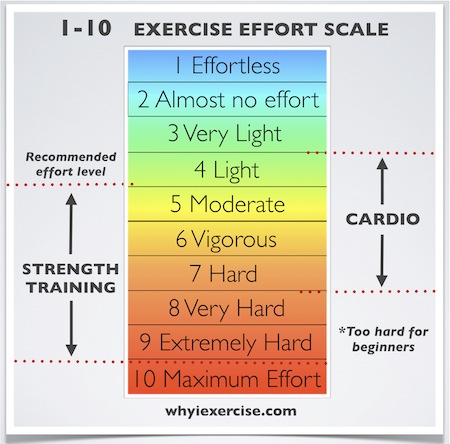
My tips on fitting exercise into your busy schedule
 time: 09:15:37
time: 09:15:37 
How to squat with proper technique
 time: 14:18:00
time: 14:18:00 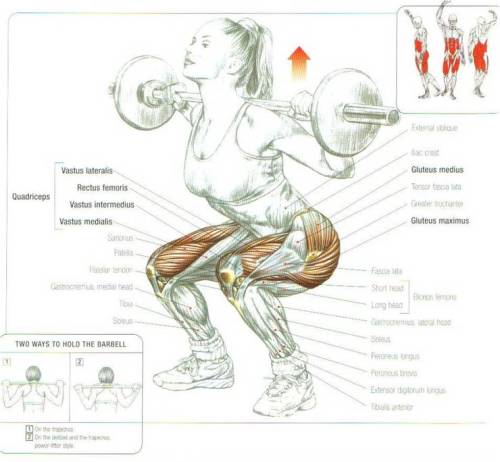
- Squats Build Muscle – Squats build muscle throughout your entire body faster than any other exercise. Squatting is a compound exercise that stresses your entire body as a complete unit. The stress put on your body by squats triggers a hormonal release of testosterone in your body. This elevated testosterone aids in producing muscle at a faster rate.
- Squats improve your athleticism – If you want to become a better athlete no other exercise will improve your overall athleticism like the squat. Squatting helps you build explosive strength that carries over to most competitive sports.
- Squats reduces injuries – Contrary to popular belief, squats do not cause injury (when performed correctly). Performing squats with proper form actually reduces the chance of injuring oneself. Why? Because squatting improves and maintains hip flexibility. Additionally, squats improve the stability of your knees, when using proper squat form.

- It is dangerous – While squatting with proper form is completely safe, squatting with poor form is extremely dangerous. Incorrect squat technique put a lot of stain on the lower back and knees and can quickly lead to serious injury.
- You are seriously compromising the benefits of squatting - When you don’t squat with proper form it completely defeats the purpose of squatting in the first place. Increased muscle, elevated testosterone, improved vertical leap – forget about it.
- You look like a complete idiot - To someone who knows how to squat properly there is nothing more pathetic than someone loading the bar up with a ton of weight than not squatting with proper form. Learn how to control your ego and do it right.
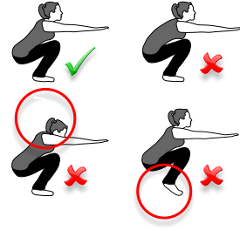
- Approach the rack with the bar at approximately mid-chest height.
- Move under the bar and place it on your back. Hold the bar in place with your hands.
- Stand with and even stance. Your feet should be shoulder width apart with your feet facing out at a 30 degree angle.
- Lift the bar out of the rack and take ONLY one step back. Take a big breath. Tense your entire body. Squat.
- Start from the hips – Bend at your hips and sit back into the squat. Imagine you are sitting down on a seat. The hips joint should always bend before your knees.
- Check your knees – Keep your knees out. Your knee joints should be pointing in the same direction as your feet all the way down. If your knee buckle in it normally means that the weight is too heavy.
- Keep your weight back – Keep your weight distributed towards your heel.
- Go all the way down – You should always aim to squat to at least parallel. Meaning, your hip joint needs to be at least parallel with your knee joint. This is incredibly difficult to judge yourself, even with the aid of a mirror. Ask someone else to assess your depth either in the gym or by video taping.
- Think about squatting up - On the way down think about squatting up. This will help to prepare your brain and make the upward movement easier.
- Bounce off the bottom – At the bottom position of the squat your hip muscles should be tight – storing energy. Use this energy to help you bounce out of the bottom of the squat. Ensure that you are bouncing off the hips – not the knees.
- Focus on your glutes – When powering up out of the squat concentrate on squeezing your glutes together.
- Drive your hips up – Most of the power for the squat comes from the hips. Drive the hips in an upward motion.
- Step forward. Ensure that your bar is over the pins before lowering the weight.
Get Your Best Legs
 time: 19:41:02
time: 19:41:02 
- the leg/harmstring curl machine
- the leg press machine
- the leg abductor/adductor machines
- squats with a barbell and/or dumbbells
- barbell deadlifts
- lunges with dumbbells
- bulgarian split squat
- wall squats
- jump squats
- bridge/hip lifts (try them with your feet on a chair/bed)
- hip lifts on a balance ball (you'll get an almost instant burn!)
- leg lifts
- inner thigh lifts
- the fire hydrant
- sumo squats
- suicides
Introduction to the different types of yoga
 time: 17:36:21
time: 17:36:21 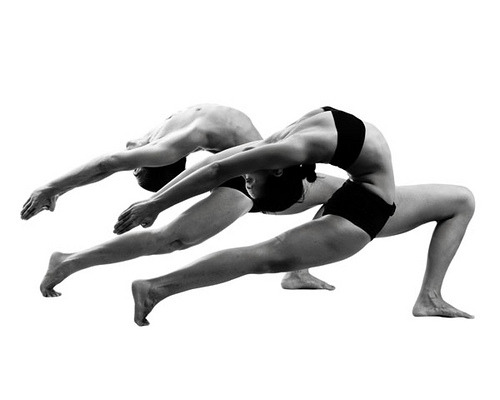
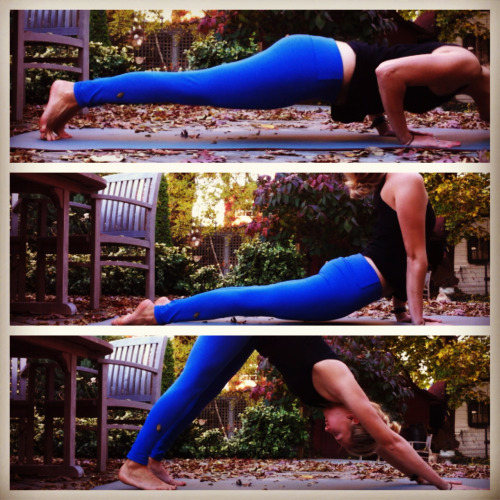
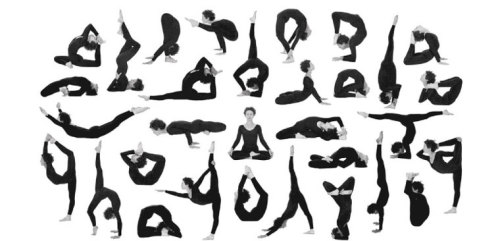
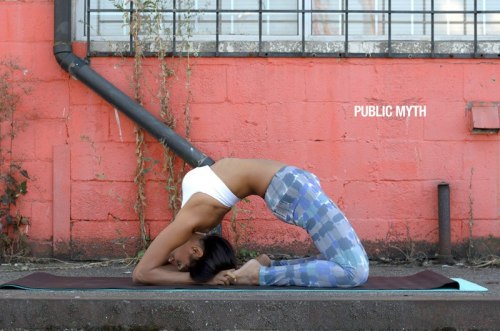

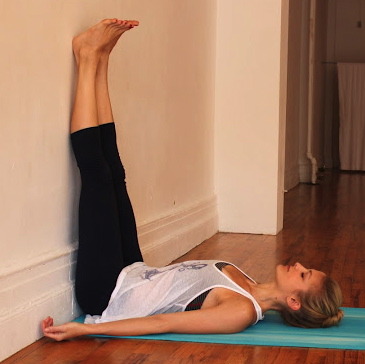
15 ways to find 15 minutes for exercise every day
 time: 21:33:43
time: 21:33:43 2. Say "No!"
Women usually have a very hard time with this one. But I think you'll really like it once you try it. Next time someone (not your big boss) asks you to do something you really don't want or need to do, say, "I'm sorry. No. I just can't", and feel the freedom - and all that free time - wash over you.
3. Plan Your Day
We all have certain times of the day when we are most focused and productive. Schedule your biggest task for that time (for many people it's in the morning, say 9:00 a.m.). You'll get it done more quickly and efficiently than if you wait to tackle it during a natural low point, like mid-afternoon.
4. Do One Thing at a Time
We pride ourselves on being supreme multitaskers, but trying to do too many things at once means getting nothing done. Sit down with your to-do list. Pick an item, and do it and only it. You'll be shocked by how quickly each task gets done when you give it your full attention.
5. Record Your Shows
A typical hour-long TV-show contains just 40 to 42 minutes of real content - the rest is commercials. Watch two shows and that's almost 40 minutes you could have spent doing something else. It's well worth investing in a digital TV-recorder so you can watch just what you want when you want, and free up time to pursue more healthful activities, like 15-minute workouts.

6. Don't Be a Neatnik
Is it really all that important that your apartment is spotless? Stop wasting precious time folding your sheets just because, and polishing picture frames and aim for an adequate level of cleanliness instead.
7. Be Decisive!
You can easily waste hours choosing what color to paint your walls or which brand of sneakers to buy (it's called analysis paralysis). At some point, you need to stop waffling and move forward. Set a time limit, say 45 minutes, for comparison shopping, weighing pros and cons, etc., then make a decision and go forth.
8. Buy Time
Pay for services that suck up tons of time. Before you pooh-pooh the idea of hiring a laundry or cleaning service, sit down and do a little math. If you've been known to blow a few hundred bucks on shoes and bags you don't really need while you slave away all your spare time scrubbing the tub, it's time to reconsider your expenditures. By hiring a cleaning service to do the heavy-duty stuff twice a month and looking into premade meal plans, you'll buy yourself hours every week.
9. Ink It On Your Calendar
Amazing how you find time for everything on your calendar, right? That's because it's there in black and white, demanding your attention (and time). Block out your workouts as you would work appointments and you won't miss them.
10. Set a Timer
Certain activities are black holes for time. All the little things you plan to do for just a few minutes - surfing the web, playing games on your phone - can suck away hours if you're not careful. Keep a kitchen timer nearby. When you start a task, set it for 15 minutes. Then stop when the bell rings.

11. Touch It Once
When a paper comes across your desk or an e-mail hits your inbox, deal with it right away. Piled up paper and messages not only create distracting clutter, you also waste time revisiting each issue again (and again) or, worse, losing something important.
12. Pick Up the Phone
Texting and emailing can be great timesavers, but sometimes it takes 15 messages to accomplish what you could do in a 40-second phone call. As soon as it starts getting complicated, pick up the phone.
13. Put Things in Their Place
I used to waste precious time looking for my keys. At any given time they could have been anywhere - pockets, drawers, purses, or my personal favorite, hanging from the door lock. Place your things on a certain place every time you put it away. Try this trick with anything you lose regularly. It works.
14. Set Out Your Stuff
Setting out your exercise clothes at night makes it far more likely that you will get up and get moving for a morning workout, instead of hitting snooze (or worse, skipping the whole affair entirely) because it's too daunting to get up and start rummaging around for your workout gear.
15. Get Up 15 Minutes Earlier
Vow to work out at 5 a.m. every day and you'll never do it. But even the most nocturnal of night owls can roll out of the sack a mere 15 minutes earlier in the morning. Even if you don't use that extra time for your workout, you'll get to the office earlier than usual, so you'll be more likely to take that 15 minutes for yourself later in the day.

My tips for "getting abs"
 time: 16:43:35
time: 16:43:35 - Eat clean (NO JUNK FOOD, choose wholesome, natural sources)
- Do cardio (HIIT is great for fat loss)
- Lift weights (Revs metabolism, and increases calorie burn over an extended period of time)
- Drink water (Your body needs water to perform basic functions like mobilize fat stores and build muscle)

- Get enough sleep (If you don't sleep enough, cortisol levels are raised, which promotes fat storage around the abdomen)
- Avoid stress (Same cortisol problem)
- Eat healthy fats (Fats like avocado, olive oil, natural peanut butter and almonds help you LOSE fat)
- Eat lean proteins (It helps keep you satiated longer and has the highest thermogenic effect of any other macronutrient)
DO THEM SQUATS
 time: 16:35:10
time: 16:35:10 
How much exercise do you REALLY need?
 time: 16:21:21
time: 16:21:21 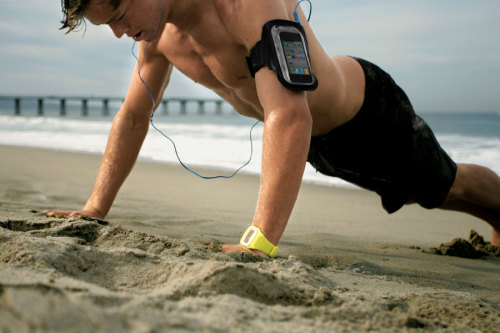
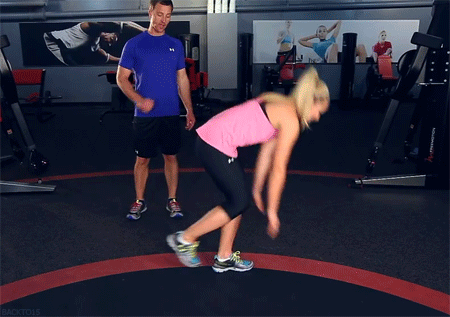
Running post UPDATED
HOW TO: Squeeze exercise into your schedule
 time: 23:13:02
time: 23:13:02  How much time do you spend sleeping? (Hopefully at least 8-9 hours a day): _____ (for me; only 5 hours, oups)
How much time do you spend sleeping? (Hopefully at least 8-9 hours a day): _____ (for me; only 5 hours, oups) How much time do you spend at school or doing homework? (Probably 8-10 hours a day): _____ (for me; aprox. 8-9 hours)
How much time do you spend at school or doing homework? (Probably 8-10 hours a day): _____ (for me; aprox. 8-9 hours) How much time do you spend eating, showering, and getting dressed? (Maybe 1-3 hours a day): _____ (for me; 2-3 hours)
How much time do you spend eating, showering, and getting dressed? (Maybe 1-3 hours a day): _____ (for me; 2-3 hours) How much time do you spend at an after-school job or doing community service?: _____ (for me; none)
How much time do you spend at an after-school job or doing community service?: _____ (for me; none) Total the mandatory hours: _____ (for me; that's 15-17 hours)
Total the mandatory hours: _____ (for me; that's 15-17 hours) Subtract this number from 24: 24 - _____ = _____ (for me; 7-9 hours)
Subtract this number from 24: 24 - _____ = _____ (for me; 7-9 hours)

RUNNING - TIPS AND TRICKS
 time: 22:43:00
time: 22:43:00 
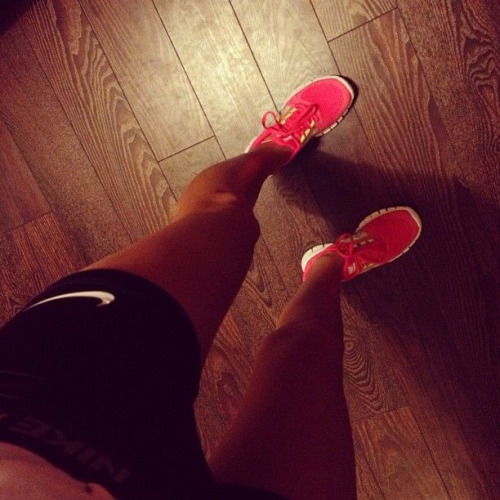






 The most important thing, I think, is to start off slowly. Don't expect that you're going to be running 5 minute miles (1½ km), or 32 kilometer (20 miles) long runs, right away. If you do too much too soon, you're going to get hurt and then you won't be doing any running. Ease into it. I think a good rule of thumb is to increase intensity by 10% each week. A lot of beginners like the Couch to 5K program.
The most important thing, I think, is to start off slowly. Don't expect that you're going to be running 5 minute miles (1½ km), or 32 kilometer (20 miles) long runs, right away. If you do too much too soon, you're going to get hurt and then you won't be doing any running. Ease into it. I think a good rule of thumb is to increase intensity by 10% each week. A lot of beginners like the Couch to 5K program. Don't be afraid to walk! Sometimes walking in the middle of a run to break it up when it gets too hard can help you extend the length of your run, thus keeping your heart rate elevated for a longer period of time, giving you the cardiovascular benefits longer.
Don't be afraid to walk! Sometimes walking in the middle of a run to break it up when it gets too hard can help you extend the length of your run, thus keeping your heart rate elevated for a longer period of time, giving you the cardiovascular benefits longer. Go to a running store and get someone who knows to help you find a running shoe that's right for you. Everyone's feet are different and as such different running shoes work best for different feet (high arches, low arches, etc.). It might be a tad pricey, but it could also prevent future injuries and treating those can be costlier.
Go to a running store and get someone who knows to help you find a running shoe that's right for you. Everyone's feet are different and as such different running shoes work best for different feet (high arches, low arches, etc.). It might be a tad pricey, but it could also prevent future injuries and treating those can be costlier. Weight training is not just for bodybuilders and football players! It helps prevent injury, and improves your speed and stamina. Don't be afraid of resistance training, just make sure you do it right.
Weight training is not just for bodybuilders and football players! It helps prevent injury, and improves your speed and stamina. Don't be afraid of resistance training, just make sure you do it right. Nike+ and RunKeeper are great apps that allows you to keep a running log of your runs, map out distances and elevations and save those routes for future use. Keeping track of what you've done can be a good motivator for the future. Setting short and long term goals can really help you stick with something and down the road you can look back with pride to see how far you've come!
Nike+ and RunKeeper are great apps that allows you to keep a running log of your runs, map out distances and elevations and save those routes for future use. Keeping track of what you've done can be a good motivator for the future. Setting short and long term goals can really help you stick with something and down the road you can look back with pride to see how far you've come! I think a big obstacle to people just starting out is actually making running a habit. If you skip a few days, that can turn into a week or two, then a month, and you're back at square one. So...schedule a run like you would schedule a doctor's appointment or a meeting or a class. I know everyone has busy schedules and often it's easy to say "I'll just run tomorrow", and by doing that it keeps getting pushed back. Set some time aside beforehand, and on a regular basis, and make that "running time". If you stick to a routine, it'll become a habit.
I think a big obstacle to people just starting out is actually making running a habit. If you skip a few days, that can turn into a week or two, then a month, and you're back at square one. So...schedule a run like you would schedule a doctor's appointment or a meeting or a class. I know everyone has busy schedules and often it's easy to say "I'll just run tomorrow", and by doing that it keeps getting pushed back. Set some time aside beforehand, and on a regular basis, and make that "running time". If you stick to a routine, it'll become a habit. It also can help to find someone to run with. If you know you're going to be running with a friend, it may help motivate you to push, or go in the first place.
It also can help to find someone to run with. If you know you're going to be running with a friend, it may help motivate you to push, or go in the first place. Get enough rest! Just like with any exercise, you're body needs time to recover, so make sure you get enough sleep, especially on days you run. It'll help with soreness and recovery time, so you can be ready for your next run!
Get enough rest! Just like with any exercise, you're body needs time to recover, so make sure you get enough sleep, especially on days you run. It'll help with soreness and recovery time, so you can be ready for your next run!
 Get enough food! I know some people start running to lose weight and it can definitely help with that. But running on a severely restricted diet is dangerous. There's 8 gazillion different nutrition plans and each of them can work for some people and not for others. Whatever diet you're on (if you are), make sure to get enough carbs, they're the primary fuel for runs and not poison as some diet plans may have you believe. Just remember that if you've just started running, you're burning more calories than you have been normally, therefore you need to eat more calories.
Get enough food! I know some people start running to lose weight and it can definitely help with that. But running on a severely restricted diet is dangerous. There's 8 gazillion different nutrition plans and each of them can work for some people and not for others. Whatever diet you're on (if you are), make sure to get enough carbs, they're the primary fuel for runs and not poison as some diet plans may have you believe. Just remember that if you've just started running, you're burning more calories than you have been normally, therefore you need to eat more calories. Keep the weather in mind. Remember that when you start running your body is going to warm up, so dress a little lighter than what would be comfortable to walk around in, and once you start running you will warm up to a more comfortable temperature. Also cotton can get soaked in sweat and become uncomfortable, and even cold in the winter, so it may be worth investing in some moisture-whicking material that all major brands sell nowadays.
Keep the weather in mind. Remember that when you start running your body is going to warm up, so dress a little lighter than what would be comfortable to walk around in, and once you start running you will warm up to a more comfortable temperature. Also cotton can get soaked in sweat and become uncomfortable, and even cold in the winter, so it may be worth investing in some moisture-whicking material that all major brands sell nowadays. Hydrate or die! Make sure, especially as you get into longer and longer distances and times, and in hotter weather, to keep yourself hydrated. If you start feeling light headed on a run, chances are you're NOT hydrated enough.
Hydrate or die! Make sure, especially as you get into longer and longer distances and times, and in hotter weather, to keep yourself hydrated. If you start feeling light headed on a run, chances are you're NOT hydrated enough. Just do it baby.
Just do it baby.Get motivated
 time: 21:44:00
time: 21:44:00 


